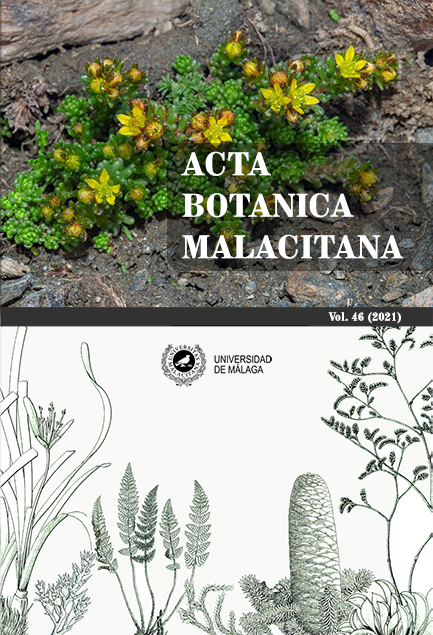Hydrocharis laevigata (Humb. & Bonpl. ex Willd.) Byng & Christenh. (Hydrocharitaceae), novelty for the flora of Andalusia (Spain)
DOI:
https://doi.org/10.24310/abm.v46i.11403Keywords:
Andalusia, Cordoba, chorology, exotic species, vascular flora, Hydrocharis, LimnobiumAbstract
Hydrocharis laevigata (Humb. & Bonpl. ex Willd.) Byng & Christenh. is reported for the first time for the Andalusian flora. This is the second record of this hydrophyte for the Iberian Peninsula, where it was known only from the province of Madrid.
Downloads
Metrics
References
Bernardini, B. & Lucchese, F. (2018). New phylogenetic insights into Hydrocharitaceae. Annali di Botanica, 8, 45-58. CABI (2019). Invasive Species Compendium [Base de datos en línea]. Limnobium laevigatum (South American spongeplant). Recurso electrónico en https://www.cabi.org/isc/datasheet/115273. Consulta realizada en diciembre de 2020. Casals, F. & Sánchez-González, J. R. (Eds) (2020). Guía de las especies Exóticas e Invasoras de los Ríos, Lagos y Estuarios de la Península Ibérica. Proyecto LIFE INVASAQUA. Ed. Sociedad Ibérica de Ictiología. 128 pp. Cook, C. D. K. (1990). Aquatic plant book. The Hague: SPB Academic Pub. 228 pp.
Cook, C. D. K. & Urmi-König, K. (1983). A revision of the genus Limnobium including Hydromystria (Hydrocharitaceae). Aquatic Botany, 17, 1-27. Corro, M., Izuzquiza, Á. & Cirujano, S. (2019). Primera cita de la especie potencialmente invasora Limnobium laevigatum (Humb. & Bonpl. ex Willd.) Heine (Hydrocharitaceae) en la Península Ibérica. BV news Publicaciones Científicas, 8(109), 75-80. Crow, G. E. & Hellquist, C. B. (2006). Aquatic and Wetland Plants of Northeastern North America. A Revised and Enlarged Edition of Norman C. Fassett's A Manual of Aquatic Plants. Volume 2: Angiosperms: Monocotyledons. Madison: The University of Wisconsin Press. 400 pp. Díaz Miranda, D., Philcox, D. & Denny, P. (1981). Taxonomic clarification of Limnobium Rich. and Hydromystria G.W.F. Meyer (Hydrocharitaceae). Botanical Journal of the Linnean Society, 83, 311-323. García Murillo, P., Fernández Zamudio, R. & Cirujano Bracamonte, S. (2010). Habitantes del agua. Macrófitos. Sevilla: Junta de Andalucía. Consejería de Medio Ambiente, Agencia Andaluza del Agua. 282 pp. Havel, J. E., Kovalenko, K. E., Thomaz, S. M., Amalfitano, S. & Kats, L. B. (2015). Aquatic invasive species: challenges for the future. Hydrobiologia, 750(1), 147-170.
Lowden, R. M. (1992). Floral variation and taxonomy of Limnobium L. C. Richard (Hydrocharitaceae). Rhodora, 94(878), 111-134.
Pimentel, D., Zuniga, R. & Morrison, D. (2005). Update on the environmental and economic costs associated with alien invasive species in the United States. Ecological Economics, 52, 273-288.
Riezing, N. (2019). Újabb adventív vízinövény Magyarországon: Limnobium laevigatum (Hydro-charitaceae). Kitaibelia, 24(1), 9-15.
Rodríguez-Merino, A., García-Murillo, P., Cirujano, S. & Fernández-Zamudio, R. (2018). Predicting the risk of aquatic plant invasions in Europe: How cli-matic factors and anthropogenic activity influence potential species distributions. Journal for Nature Conservation, 45, 58-71.
Simberloff, D., Martin, J. L., Genovesi, P., Maris, V., Wardle, D. A., Aronson, J., Courchamp, F., Galil, B., García-Berthou, E., Pascal, M., Pyšek, P., Sousa, R., Tabacchi, E. & Vila, M. (2013). Impacts of biological invasions: what's what and the way forward. Trends in Ecology & Evolution, 28(1), 58-66.
Tanaka, N., Setoguchi, H. & Murata, J. (1997). Phylogeny of the Famiiy Hydrocharitaceae inferred from rbcL and matK Gene Sequence Data. Journal of Plant Research, 110, 329-337.
WCSP (2020). World Checklist of Selected Plant Families. Facilitated by the Royal Botanic Gardens, Kew. Recurso electrónico en http://wcsp.science.kew.org/ Consulta realizada en diciembre de 2020.
Downloads
Published
How to Cite
Issue
Section
License
All information related to the licensing of published works in Acta Botanica Malacitana and copyright can be found in our Editorial Policy.







1.png)
